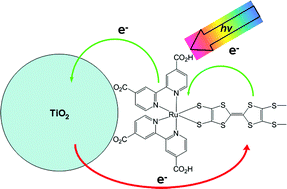Characterisation of a ruthenium bipyridyl dye showing a long-lived charge-separated state on TiO2 in the presence of I−/I3−†
Abstract
The control of the loss mechanism in a

* Corresponding authors
a
School of Chemistry, University of Edinburgh, King's Buildings, Edinburgh, UK
E-mail:
neil.robertson@ed.ac.uk
Fax: +44 1316504743
Tel: +44 1316504755
b Department of Chemistry, Imperial College, London, UK
The control of the loss mechanism in a

 Please wait while we load your content...
Something went wrong. Try again?
Please wait while we load your content...
Something went wrong. Try again?
K. L. McCall, A. Morandeira, J. Durrant, L. J. Yellowlees and N. Robertson, Dalton Trans., 2010, 39, 4138 DOI: 10.1039/B924660F
To request permission to reproduce material from this article, please go to the Copyright Clearance Center request page.
If you are an author contributing to an RSC publication, you do not need to request permission provided correct acknowledgement is given.
If you are the author of this article, you do not need to request permission to reproduce figures and diagrams provided correct acknowledgement is given. If you want to reproduce the whole article in a third-party publication (excluding your thesis/dissertation for which permission is not required) please go to the Copyright Clearance Center request page.
Read more about how to correctly acknowledge RSC content.
 Fetching data from CrossRef.
Fetching data from CrossRef.
This may take some time to load.
Loading related content
